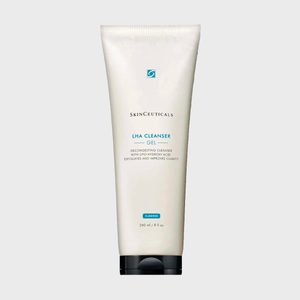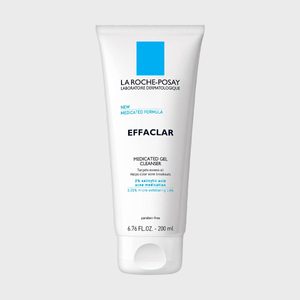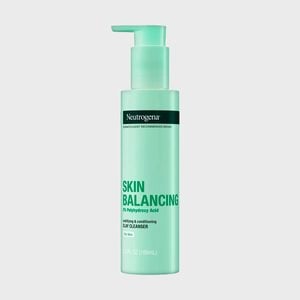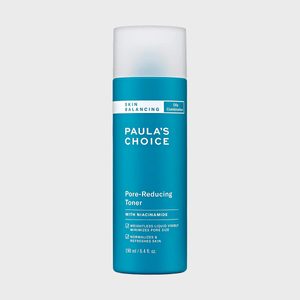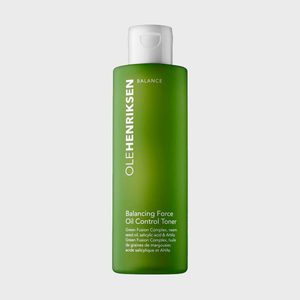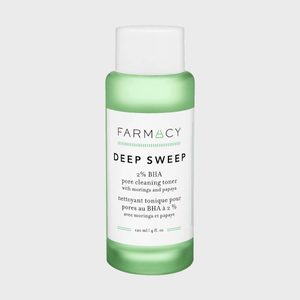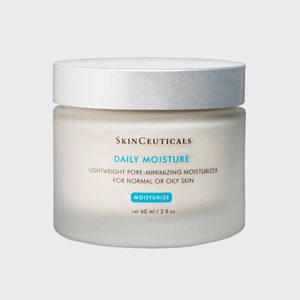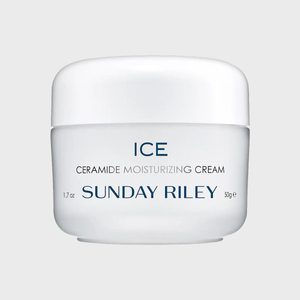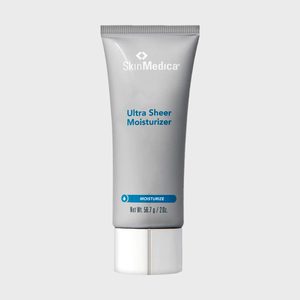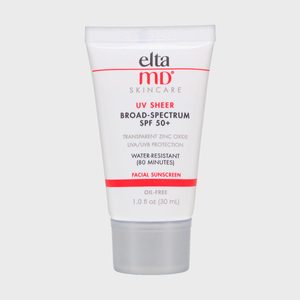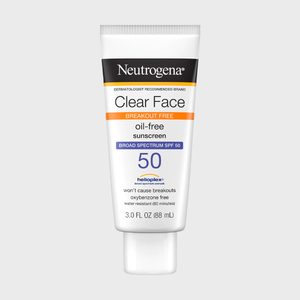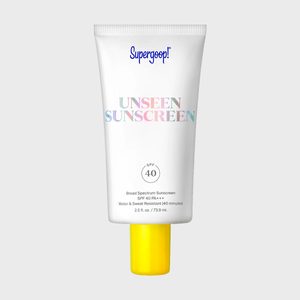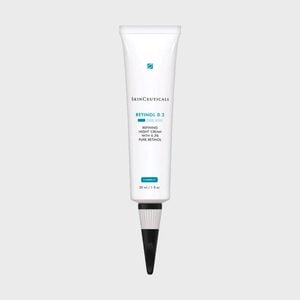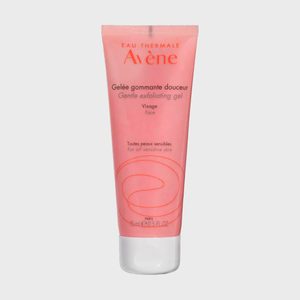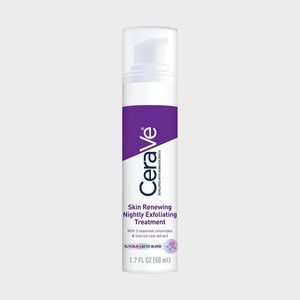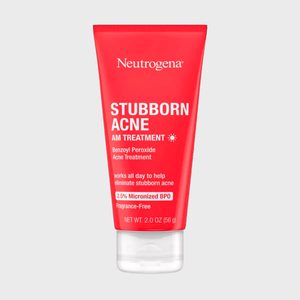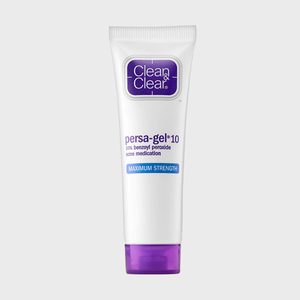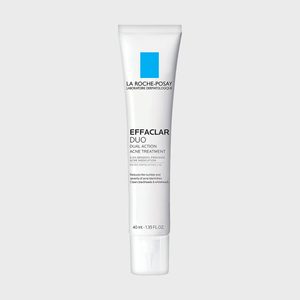The Best Skin-Care Routine for Oily Skin, According to Dermatologists
Updated: Jun. 26, 2024

We have the steps and products it takes to create a great skin-care routine for oily skin—straight from dermatologists
Our editors and experts handpick every product we feature. We may earn a commission from your purchases.Learn more.
Oily skin is exactly what it sounds like: skin characterized by the production of a lot of oil. If you’re constantly dealing with shininess, always feel like your face has been hit by an oil slick by the end of the day or tend to notice a bit of oil buildup across your nose and forehead, it may be time to invest in a skin-care routine for oily skin. That’s right: Just as there’s an ideal skin-care routine for people in their 30s versus those in their 60s, and just as skin care for men differs slightly from routines meant for women, there are best practices when it comes to your skin type.
Need another reason to target oily skin with your daily regimen? Because it produces so much oil (also known as sebum), this skin type often goes hand in hand with acne. But take heart: If you’re battling breakouts, you’re in good company. According to the American Academy of Dermatology, acne is the most common skin condition in the United States and impacts approximately 50 million people per year.
Luckily, there are great skin-care brands that can help oily skin avoid acne and stay healthy, and some formulas may even help curb oil production. Finding the best skin-care routine for oily skin just takes a little know-how, so we reached out to board-certified dermatologists Corey L. Hartman, MD, founder of Skin Wellness Dermatology in Birmingham, Alabama, and David Kim, MD, of Idriss Dermatology in New York City, to find out what makes a great oily-skin routine.
Get Reader’s Digest’s Read Up newsletter for more skin-care and beauty tips, humor, cleaning, travel, tech and fun facts all week long.
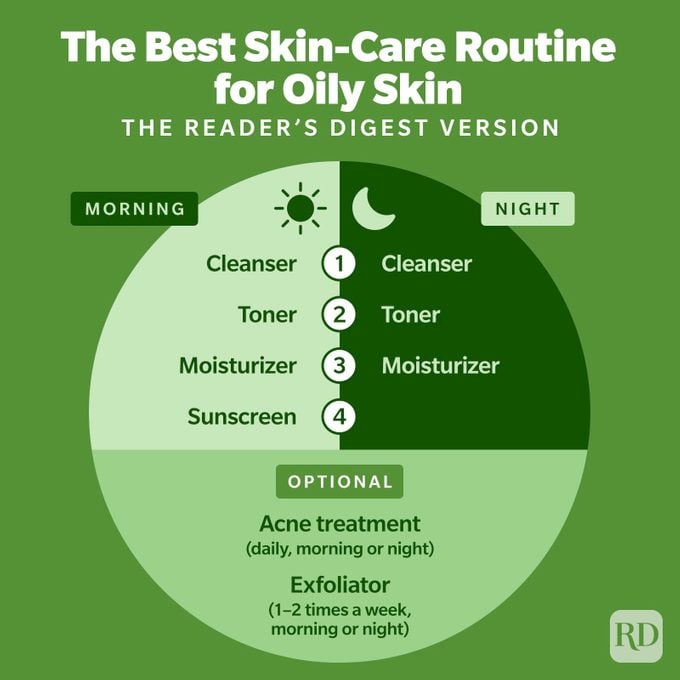
What causes oily skin?
“Oily skin is genetic, and it has to do with the size and activity of the oil glands that are associated with the hair follicles,” Dr. Hartman explains. “That means if you have thicker hair, you may have thicker or larger oil glands.”
Another thing that can impact the amount of oil your skin produces? Hormones. That’s why acne, which is so often associated with oily skin, commonly shows up during puberty, and for those who menstruate, around their periods.
Now that you know what triggers oiliness, it’s time to put together your ideal skin-care routine for oily skin—and it’s simpler than it sounds. As Dr. Kim notes, when it comes to oily skin types, less is more. “It’s best not to add too many layers for oily skin,” he says. “Otherwise, it can clog your pores and cause acne flares.”
If you’re ready to get glowing (but not shiny!) skin, follow the regimen below. Trust us: Skin care for oily skin has never been easier.
What is the best skin-care routine for oily skin?
The heart of a good skin-care routine for oily skin has four main daily steps:
- Cleanser
- Toner
- Moisturizer
- Sunscreen
There are additional steps you can add in if necessary or as needed:
- Exfoliator
- Acne treatment
If hitting all those steps sounds intimidating, don’t worry. We have everything you need to know, including product recommendations.
1. Cleanser
Every good skin-care routine—including one for oily skin—begins with a good cleanser. You want to use it twice a day: Once in the morning to prep your skin to apply your products, and again at night to take off any debris you’ve collected throughout the day.
You might’ve heard that you can skip a morning cleansing, but rinsing without washing is better suited to a skin-care routine for dry skin. If yours is oily, go ahead and use a cleanser in the morning and at night.
Find the best cleanser for oily skin
Dr. Hartman says that for oily skin, the best face wash is likely “something a little astringent” that uses hydroxy acids or benzoyl peroxide. “You don’t want to do so much that it pushes you in the direction of overly drying,” he explains. That can lead your skin to produce more oil, a process called rebound oiliness.
As for the best face wash formulations, Dr. Hartman recommends staying away from oils, which can sometimes be comedogenic. (In other words, they can clog your pores.) Instead, look for gel, foam or cream cleansers.
2. Toner
Toner is technically an optional skin-care step, but many dermatologists recommend it for oily skin because it can help regulate sebum. These watery formulas are meant to eliminate any leftover makeup and grime left after cleansing, while treating the skin with helpful ingredients.
What’s the best way to use them? “Once or twice a day on a cotton pad,” says Dr. Kim. “Apply to [your] full face.”
Find the best toner for oily skin
The best toner for you depends on your goals: Are you aiming for better skin texture? Regulated oil production? A combination of both? According to Dr. Kim, if you have oily skin, look for gentle exfoliating acids, such as glycolic or lactic acid, to gently resurface the skin. Or go with salicylic acid to help with sebum control (that’s the superstar ingredient in Paula’s Choice’s bestselling BHA liquid exfoliant).
You’ll know you’ve found the right one when your skin feels soft and smooth after use, not tight or dry. Luckily, unlike the harsh toners of the past, today’s formulas are much gentler and more foolproof.
3. Moisturizer
Yes, oily skin needs moisturizer. It may sound counterintuitive, but keeping your skin moisturized means it won’t have to work as hard to keep hydration levels up! In fact, Dr. Hartman says it’s one of the keys to holding off rebound oiliness. You want to use it morning and night, after cleansing.
Find the best moisturizer for oily skin
When looking for the best moisturizer for oily skin, the formula is everything. “I like things that are less creamy and more like a serum or gel base,” says Dr. Hartman. “You want something light, nothing too heavy, nothing too emollient,” he explains. In other words, look for terms like daily or sheer, and skip thicker formulas—night creams and bottles marked intense may be too heavy for oily skin. One thing to stay away from: oils, as they can be comedogenic, meaning they may clog pores.
4. Sunscreen
Sun damage impacts every skin type, including oily skin, so having SPF in your morning routine is non-negotiable. And, yes, that means you need to use it year-round, even on cloudy days and in the winter. (And don’t forget the scalp sunscreen!)
Admittedly, sunscreen can make your skin look a little oily, so finding a nongreasy sunscreen is essential (more on that in a second). But Dr. Kim reassures us that’s not impossible. “If you’re using good skin care that helps exfoliate and regulate sebum production, you should be able to wear sunscreen without feeling too greasy,” he says.
Find the best sunscreen for oily skin
When it comes to the best face sunscreens for oily types, lightweight daily formulas win. Just be sure yours has an SPF of 30 or higher.
Whether you reach for a mineral or chemical sunscreen is a matter of personal preference, and it often comes down to how they wear on your skin (mineral sunscreens can sometimes leave a white cast). “The goal is to find your favorite sunscreen—chemical or mineral—and actually use it every day,” says Dr. Kim.
Powder sunscreens are a good option for touching up oily skin—they allow you to reapply SPF on the go while soaking up oil. Sunscreen oils, on the other hand, are best avoided. “These can clog the pores,” he says.
Exfoliant
Exfoliators help remove the dead skin cells that can mix with sebum and clog pores, which is why exfoliating can be an important step in your routine.
There are two categories of exfoliants: chemical (like glycolic and salicylic acid or retinol, which increases cell turnover) and physical (scrubs that use friction). Dr. Hartman recommends starting with chemical exfoliators, as “they’re a more controlled way of exfoliation,” he says.
Apply an exfoliator once or twice a week—or more if your skin can handle it—either in the morning or at night. You may need to start slow, only using it more often if you don’t experience irritation. Beyond that, exfoliate only for very special events, when you really want a glow. That way, you won’t trigger irritation.
Find the best exfoliant for oily skin
Dr. Hartman’s go-to products for oily skin are prescription retinoids or over-the-counter retinols—not surprising, as these vitamin A derivatives are darlings of the dermatology world. But retinoids are harsh chemicals. “For retinol, start using a pea-size [amount] only twice weekly, and let your skin develop tolerance,” says Dr. Kim. You’ll want to apply retinol at night and be extra careful about wearing sunscreen during the day.
For folks who don’t tolerate them well, Dr. Hartman says an alpha hydroxy acid (like glycolic acid) or beta hydroxy acid (like salicylic acid) is a great alternative. If you prefer a physical facial scrub, remember: The finer the particles, the better.
Acne treatment
First, forget about spot-treating blemishes—if you’re dealing with acne, Dr. Kim insists it’s best to treat your whole face. That way, you prevent breakouts before they have a chance to form. And if you’re struggling with breakouts, he says, “you should use at least one prescription cream on your full face to treat existing pimples and prevent new ones.”
Heads up: Retinoids don’t just aid exfoliation; they can treat acne too. (Adapalene, in particular, is a good pick. The retinoid is approved by the Food and Drug Administration for the treatment of acne and is sold in drugstores under the brand name Differin.) If you’re using a retinoid for acne control and have sensitive skin, you may want to consider this your combo acne and exfoliating treatment. It covers both needs, and including an additional exfoliant in your skin-care routine may cause irritation, especially if your skin is sensitive.
Find the best acne treatments for oily skin
If acne is something you grapple with more than occasionally, see your dermatologist for a prescription cream—your doctor will pick the formula that’s best for your skin. If it’s a retinoid, you’ll use this at night.
But if you only experience the occasional pimple and would rather go for an over-the-counter option, you’ve got some choices. First things first: You’re going to want a cream rather than a medicated face wash. Sure, face washes offer some acne-fighting ingredients, but you wash them away almost immediately. “Acne wash stays on your face for five seconds, so you need something that will stay on your skin the whole day or night,” Dr. Kim explains.
While you may see a few other ingredients (like azelaic acid) pop up in the acne world, when it comes to OTC options, there are two all-star ingredients: salicylic acid and benzoyl peroxide. Both are effective, but of the two, benzoyl peroxide tends to get a little more love—it’s especially effective when combined with antibiotics (under a doctor’s care), according to the Mayo Clinic. In fact, the American Academy of Pediatrics calls it “the most effective acne treatment you can get without a prescription.”
Just be aware that it can bleach fabrics, so make sure to let it really soak in before getting dressed. And, again, make sure to apply it to your whole face, not just one pimple. Remember, your goal is to avoid pimples in the first place.
Skin-care tips experts swear by
Armed with our dermatologist-approved skin-care routine for oily skin, you’re well on your way to a less-greasy face. But there are a couple more things to consider as you follow this regimen.
Skin care and exercise
You know you need to wash your face in the morning and at night. But what if you’re feeling particularly grimy midday? If you work out in the middle of the day, for instance, should you wash your face if you have oily skin? “You probably don’t need to do that,” says Dr. Hartman. “Twice a day is enough.”
Adding an additional cleansing session may dry your skin out, causing more oiliness. You do want to rinse your face, however. That’ll prevent the sweat, debris and oil from mixing and clogging your pores. And it has the added bonus of leaving you refreshed after a grueling workout.
Smart product use
Take your time when introducing ingredients. Before slathering a new product all over your face, do a spot test to make sure your skin can handle it. And when dealing with ingredients like benzoyl peroxide and retinoids, which some people find irritating, start slow to acclimate your face, building to more frequent use as your skin adjusts to the ingredient.
Sources:
- Corey L. Hartman, MD, board-certified dermatologist and founder of Skin Wellness Dermatology in Birmingham, Alabama
- David Kim, MD, board-certified dermatologist with Idriss Dermatology in New York City
- American Academy of Dermatology: “Skin Conditions by the Numbers”
- America Academy of Dermatology: “Retinoid or Retinol?”
- Mayo Clinic: “Nonprescription acne treatment: Which products work best?”
- American Academy of Pediatrics: “Teens and Acne Treatment”





















